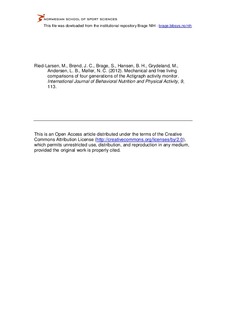| dc.contributor.author | Ried-Larsen, Mathias | |
| dc.contributor.author | Brønd, Jan Christian | |
| dc.contributor.author | Brage, Søren | |
| dc.contributor.author | Hansen, Bjørge Herman | |
| dc.contributor.author | Grydeland, May | |
| dc.contributor.author | Andersen, Lars Bo | |
| dc.contributor.author | Møller, Niels C. | |
| dc.date.accessioned | 2012-11-14T12:54:43Z | |
| dc.date.available | 2012-11-14T12:54:43Z | |
| dc.date.issued | 2012-09-12 | |
| dc.identifier | Seksjon for idrettsmedisinske fag / Department of Sports Medicine | |
| dc.identifier.citation | International Journal of Behavioral Nutrition and Physical Activity. 2012, 9, 113 | no_NO |
| dc.identifier.issn | 1479-5868 | |
| dc.identifier.uri | http://hdl.handle.net/11250/171042 | |
| dc.description | © 2012 Ried-Larsen et al.; licensee BioMed Central Ltd. | no_NO |
| dc.description.abstract | Background
More studies include multiple generations of the Actigraph activity monitor. So far no studies have compared the output including the newest generation and investigated the impact on the output of the activity monitor when enabling the low frequency extension (LFE) option. The aims were to study the responses of four generations (AM7164, GT1M, GT3X and GT3X+) of the Actigraph activity monitor in a mechanical setup and a free living environment with and without enabling the LFE option.
Methods
The monitors were oscillated in a mechanical setup using two radii in the frequency range 0.25-3.0 Hz. Following the mechanical study a convenience sample (N = 20) wore three monitors (one AM7164 and two GT3X) for 24 hours.
Results
The AM7164 differed from the newer generations across frequencies (p < 0.05) in the mechanical setup. The AM7164 produced a higher output at the lower and at the highest intensities, whereas the output was lower at the middle intensities in the mid-range compared to the newer generations. The LFE option decreased the differences at the lower frequencies, but increased differences at the higher. In free living, the mean physical activity level (PA) of the GT3X was 18 counts per minute (CPM) (8%) lower compared to the AM7164 (p < 0.001). Time spent in sedentary intensity was 26.6 minutes (95% CI 15.6 to 35.3) higher when assessed by the GT3X compared to the AM7164 (p < 0.001). Time spend in light and vigorous PA were 23.3 minutes (95% CI 31.8 to 14.8) and 11.7 minutes (95% CI 2.8 to 0.7) lower when assessed by the GT3X compared to the AM7164 (p < 0.05). When enabling the LFE the differences in the sedentary and light PA intensity (<333 counts*10 sec-1) were attenuated (p > 0.05 for differences between generations) thus attenuated the difference in mean PA (p > 0.05) when the LFE option was enabled. However, it did not attenuate the difference in time spend in vigorous PA and it introduced a difference in time spend in moderate PA (+ 3.0 min (95% CI 0.4 to 5.6)) between the generations.
Conclusion
We observed significant differences between the AM7164 and the newer Actigraph GT-generations (GT1M, GT3X and GT3X+) in a mechanical setup and in free-living. Enabling the LFE option attenuated the differences in mean PA completely, but induced a bias in the moderate PA intensities. | no_NO |
| dc.language.iso | eng | no_NO |
| dc.publisher | BioMed Central | no_NO |
| dc.subject | accelerometry | no_NO |
| dc.subject | physical activity assessment | no_NO |
| dc.subject | physical activity intensity | no_NO |
| dc.subject | mechanical testing | no_NO |
| dc.subject | free living | no_NO |
| dc.title | Mechanical and free living comparisons of four generations of the Actigraph activity monitor | no_NO |
| dc.type | Journal article | no_NO |
| dc.type | Peer reviewed | no_NO |
| dc.subject.nsi | VDP::Social science: 200::Social science in sports: 330 | no_NO |
| dc.subject.nsi | VDP::Medical disciplines: 700::Sports medicine: 850 | no_NO |
| dc.source.pagenumber | 113 | no_NO |
| dc.source.volume | 9 | no_NO |
| dc.source.journal | International Journal of Behavioral Nutrition and Physical Activity | no_NO |
